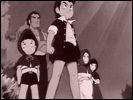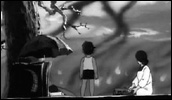Barefoot Gen
- Year
- 1983
- Original title
- Hadashi no Gen
- Japanese title
- はだしのゲン
- Director
- Cast
- Running time
- 85 minutes
- Published
- 21 September 2005



by Jasper Sharp
Sixty years ago, on August 6th 1945, the most devastating weapon known to mankind was unleashed, for the first time ever, upon the Japanese city of Hiroshima. Dispatched from the US bomber Enola Gay, the absurdly-nicknamed "Little Boy" wiped out 80,000 civilian targets in one fell swoop and destroyed 48,000 of the city's 76,000 buildings. It was followed a few days later, on August 9th, with the dropping of "Fat Man" on Nagasaki by the bomber Bockscar, with similarly catastrophic results. By 1950, the radioactive after-effects had claimed a total of 200,000 victims in Hiroshima alone, lingering on to blight the city's "hibakusha" blast survivors and generations of their bloodline with a host of radiation-induced sicknesses including blindness, liver disorders, chronic fatigue, leukaemia and numerous types of cancer.
Written by Keiji Nakazawa, who was only six years old when the bomb fell on his hometown of Hiroshima, Barefoot Gen is a classic title from the world of Japanese manga and anime. Told through the eyes of his fictional alter ego Gen Nakaoka (whose name, especially in the katakana form in which it is given in the title, seems to intentionally allude to the 'atomic' part of the Japanese word for the A-bomb, "genbaku"), Nakazawa's semi-autobiographical account originally appeared serialised in 1973 in the manga magazine Weekly Shonen Jump (Shûkan Shonen Jampu). The various episodes have subsequently been collected and published together in a series of four volumes, and an English translation is available.
Nakazawa's story was first brought to the screen in three live-action movies produced by Gendai Production directed by Tengo Yamada in the latter half of the 70s; Hadashi no Gen (1976), Hadashi no Gen: Namida no Bakuhatsu [Trans: Barefoot Gen: Explosion of Tears, 1977] and Hadashi no Gen Part 3: Hiroshima no Tatakai [Trans: Barefoot Gen: Battle of Hiroshima, 1980], which enlisted the services of such renowned actors as Rentaro Mikuni (playing Gen's father). However, these obscure productions seem to have been virtually forgotten in favour of Masaki Mori's animated version from 1983, whose powerful invocations of what it must have been like to be a young child caught in the midst of a truly horrible war foretell Isao Takahata's Grave of the Fireflies (1988) from Studio Ghibli.
Even more so than Takahata's film, the events chronicled in Barefoot Gen hardly seem the most suitable material for cartoon treatment. Still, over the past few decades few nations have been as active or adept when it comes to pushing commercial animation in such original and unexpected directions as the Japanese. In fact on further reflection it might appear equally futile trying to recreate the full immediacy of the bomb on live-action film, though it is worth mentioning Peter Watkins' production of The War Game for the BBC in 1967, which adopted the format of a simulated news documentary to depict what might happen if the English county of Kent was subjected to a nuclear strike. When it was made in the midst of the Cold War period, Watkins' radical vérité approach proved so relentlessly harrowing and his conclusions so politically inflammatory that the British government intervened to ensure that it was never aired on television for a full 25 years.
But ultimately perhaps the more manifestly "unreal" nature of the anime format, constructed completely by hand rather than assembled from fragments of captured or staged reality (as in Watkins' film), is better suited to presenting the subjective experiences of the A-bomb survivors. The very presentational style in Barefoot Gen's more apocalyptic moments can't help but draw our attention to what is being portrayed. What we are witnessing may not be real, but we know that it happened.
Given their subject matter, comparisons between Barefoot Gen and Grave of the Fireflies are inevitable, though it can't be ignored that in terms of quality of the animation, Mori's film comes out the poorer. This is evident not only in the more obviously cartoonish rounded character designs, but in the surfeit of shortcuts to disguise the lack of actual animation, such as lateral pans across static images. But then again, we are comparing it with a work from the most accomplished animation studio in the industry, and also bear in mind it was made 5 years earlier.
The two films' dramatic arcs also couldn't be more different. Rather than the constructed fiction of the Ghibli movie, Barefoot Gen's narrative is a pretty straightforward chronicle of one boy's life at a critical point in history. The film opens, documentary-style, during the last days of the Pacific War, with a voice-of-god narrator setting the scene before introducing us to Gen's family. His father Daikichi, already convinced of Japan's defeat, harbours strong anti-war sentiments, which has made him something of a thorn in the side of his local community. With major areas in Tokyo, Nagoya, Osaka and Okinawa already laid waste by the Allied carpet bombing campaign, he muses as to why such a strategic settlement as Hiroshima has yet to be targeted.
The early scenes unfold against a backdrop of food shortage and air raid warnings. With Gen's heavily pregnant mother Kimie effectively out of action, the family are reliant upon older sister Eiko to bring in money to feed the family by selling wooden "geta" clogs. The initial focus is on the various scrapes and escapades that Gen and young brother Shinya get themselves into, such as when the two brothers are caught breaking into the grounds of a local temple to steal carp when a neighbour tells them that the fish's blood make an ideal tonic for strengthening the constitution of their exhausted mother.
But as whimsical as these portrayals of wartime hardship may be, an oppressive air of anticipation lingers over the first half hour of the film. As the dark shadow of an American bomber crawling sluggishly over the horizon signals the end of the calm before the storm, a trail of ants starts crawling prophetically back into the house, and as the bomb detonates, Gen is caught frozen in the act of picking up a stone from the street outside.
The subsequent sequences are disturbing in the extreme, especially in light of what has gone before. As the sky lights up "brighter than a thousand suns" in a myriad of colours that resemble an isolated frame from a Stan Brakhage film, a little girl clutching a doll melts in the glare, her eyeball tumbling gruesomely from her skull. Scorched bodies appear through the fog, arms outstretched, groaning and trailing dead skin behind them, like George Romero's zombies. Mori's film spares none of the gory details of Nakazawa's account: the scorched survivors leaping into the river to bring relief to their burns; maggots writhing in open wounds; military personnel hauling corpses into the back of a truck; one soldier disgorging blood though his anus before he collapses dead. But life must go on for Gen, even after the loss of most of his family members. As the toxic "black rain" begins to fall around him, finding uncontaminated food and water is the most immediate preoccupation, and the loss of his hair seems the least of his worries.
Optimum Releasing's premiere of the film on DVD in the UK has been well-timed to coincide with the 60th anniversary of the bombings of Hiroshima and Nagasaki, reminding us, as if we didn't know already, of the full horrors that man is capable of inflicting on his fellows. The disk also includes the sequel directed by Toshio Hirata, Barefoot Gen 2, which, made three years later, continues Gen's story - making the package incredible value for money.
I've seen more than one online review stating that the strong images presented in Barefoot Gen make this an unsuitable work for children. I am inclined to disagree. Aside from the fact that kids of my generation managed to cope with two hours of rabbits tearing each other's throats out, being squashed on roads, buried in their burrows and dying of myxomatosis in Watership Down (1978), Nakazawa's intention with this story was always to ensure a fuller awareness of the A-bomb in order to make sure that an atrocity on this scale never happens again. With the lives of innocent children across the world still affected by wars waged by adults and the threat of the bomb still with us, it is perhaps never too early to open the eyes of children to the world we've created.